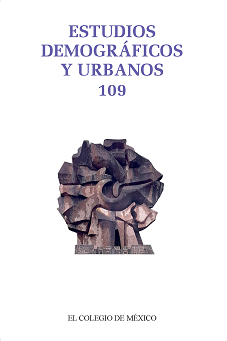Salarios y riesgos laborales de los inmigrantes mexicanos en Estados Unidos
Publicado 2022-03-03
Palabras clave
- accidentes laborales,
- salarios,
- migración indocumentada,
- regresión cuantílica,
- México
- Estados Unidos. ...Más
Cómo citar
-
Resumen2790
-
PDF (español)1333
-
En línea (español)843
-
EPUB (español)34
-
Kindle (español)76
-
Audio (español)5
Descargas
Derechos de autor 2022 Estudios Demográficos y Urbanos

Esta obra está bajo una licencia internacional Creative Commons Atribución-NoComercial-SinDerivadas 4.0.
Métrica
Resumen
La realidad de los inmigrantes mexicanos en Estados Unidos muestra que, en los últimos años, se ha presentado una notable prevalencia a sufrir accidentes o padecer enfermedades estrechamente ligadas a su actividad laboral. Su estatus migratorio, el bajo capital humano y el desconocimiento del idioma inglés, son algunos de los elementos que orillan a los trabajadores a insertarse en actividades que ponen en riesgo su salud e integridad física. Con base en datos de la Encuesta sobre Migración en la Frontera Norte de México, se lleva a cabo un análisis descriptivo y se estiman regresiones cuantílicas para analizar la relación que existe entre el salario que perciben los trabajadores mexicanos en Estados Unidos y los accidentes o enfermedades en que incurren como resultado de su trabajo. Se observa que los mexicanos que laboran de manera legal en Estados Unidos perciben mayores salarios y sufren menos accidentes laborales que sus pares que trabajan de manera indocumentada. Además, los resultados sugieren que entre los trabajadores indocumentados existe una prima salarial por trabajar en ocupaciones riesgosas, particularmente en la parte superior de la distribución salarial.
Referencias
- Anthony, M., Martin, E., Avery, A. y Williams, J. (2010). Self-care and health-seeking behavior of migrant farmworkers. Journal of Immigrant and Minority Health, 12(5), 634-639. https://link.springer.com/article/10.1007/s10903-009-9252-9 DOI: https://doi.org/10.1007/s10903-009-9252-9
- Arcury, T. A., Mora, D. y Quandt, A. (2015). You earn money by suffering pain: Beliefs about carpal tunnel syndrome among Latino poultry processing workers. Journal of Immigrant Minority Health, 17, 791-801. https://link.springer.com/content/pdf/10.1007/s10903-013-9967-5.pdf DOI: https://doi.org/10.1007/s10903-013-9967-5
- Arenas, E., Goldman, N., Pebley, A. y Teruel, G. (2015). Return migration to Mexico: Does health matter? Demography, 52(6), 1853-1868. https://www.ncbi.nlm.nih.gov/pmc/articles/PMC4644732/ DOI: https://doi.org/10.1007/s13524-015-0429-7
- Arif, A., Hughes, P. C. y Delclos, G. L. (2008). Occupational exposures among domestic and industrial professional cleaners. Occupational Medicine, 58(7), 458-463 https://pubmed.ncbi.nlm.nih.gov/18628247 DOI: https://doi.org/10.1093/occmed/kqn082
- Bautista, E., Sandoval, J., Vallarta-Robledo, J., Moreno, B., Liu, J. y Johnstone, K. (2018). Social determinants of self-rated health and health access in the U.S.A. using the EMIF (Encuesta sobre Migración en la Frontera Norte de México) survey from 2012-2016. En Migration and Health: Reflections and challenges about the health of migrants (pp. 175-184). Ciudad de México: Segob / Conapo / UC Berkeley.
- Borjas, G. (2006). Wage trends among disadvantage minorities. En R. Blank, S. Danzinger y R. Schoeni (eds.), Working and poor. How economic and policy changes are affecting low-wage workers (pp. 59-86). Nueva York: Russel Sage Foundation.
- Borjas, G. y Katz, L. (2007). The evolution of the Mexican-born workforce in the United States. En G. J. Borjas (ed.), Mexican immigration to the United States (pp. 13-56). Chicago: University of Chicago Press. DOI: https://doi.org/10.7208/chicago/9780226066684.003.0002
- Bureau of Labor Statistics (2017). Fatal occupational injuries to foreign-born workers. United States: The Economics Daily.
- Cartwright, M. S., Walker, F. O., Blocker, J. N., Schulz, M. R., Arcury, T. A., Grzywacz, J. G., Mora, D., Chen, H., Marín, A. J. y Quandt, S. A. (2012). The prevalence of carpal tunnel syndrome in Latino poultry processing workers and other Latino manual workers. Journal of Occupational and Environmental Medicine, 54(2), 198-201. https://www.ncbi.nlm.nih.gov/pmc/articles/PMC3275671/ DOI: https://doi.org/10.1097/JOM.0b013e31823fdf53
- Chávez, S. y Altman, C. E. (2017). Gambling with life: Masculinity, risk, and danger in the lives of unauthorized migrant roofers. American Journal of Industrial Medicine, 60(6), 537-547. https://pubmed.ncbi.nlm.nih.gov/28514026/ DOI: https://doi.org/10.1002/ajim.22721
- Cheong, A. R. y Massey, D. S. (2019). Undocumented and unwell: Legal status and health among Mexican migrants. International Migration Review, 53(2), 571-601. https://journals.sagepub.com/doi/abs/10.1177/0197918318775924 DOI: https://doi.org/10.1177/0197918318775924
- Consejo Nacional de Población. (Conapo). (2013). Migración y salud. Inmigrantes mexicanos en Estados Unidos. http://www.conapo.gob.mx/work/models/CONAPO/Resource/1759/1/images/Migracion_y_Salud_Inmigrantes_Mexicanos_en_Estados_Unidos.pdf
- Crocker, R. (2015). Emotional testimonies: An ethnographic study of emotional suffering related to migration from Mexico to Arizona. Frontiers in Public Health, 3, 1-11. https://www.frontiersin.org/articles/10.3389/fpubh.2015.00177/full DOI: https://doi.org/10.3389/fpubh.2015.00177
- Durand, J. y Massey, D. S. (2019). Debacles on the border: Five decades of fact-free immigration policy. The Annals of the American Academy of Political and Social Science, 684(1), 6-20. https://journals.sagepub.com/doi/abs/10.1177/0002716219857647 DOI: https://doi.org/10.1177/0002716219857647
- Eggerth, D. E., Ortiza, B., Keller, B. M. y Flynn, M. A. (2019). Work experience of Latino building cleaners: An exploratory study. American Journal of Industrial Medicine, 62(7), 600-608. https://pubmed.ncbi.nlm.nih.gov/31104342/ DOI: https://doi.org/10.1002/ajim.22986
- Fernández-Esquer, M. E., Gallardo, K. R. y Diamond, P. M. (2019). Predicting the influence of situational and immigration stress on Latino day laborers’ workplace injuries: An exploratory structural equation model. Journal of Immigrant and Minority Health, 21(2), 364-371. https://europepmc.org/article/med/29767403 DOI: https://doi.org/10.1007/s10903-018-0752-3
- Gany, F., Dobslaw, R., Ramirez, J., Tonda, J., Lobach, I. y Leng, J. (2011). Mexican urban occupational health in the US: A population at risk. Journal of Community Health, 36(2), 175-179. https://pubmed.ncbi.nlm.nih.gov/20614170/ DOI: https://doi.org/10.1007/s10900-010-9295-9
- Gany, F., Novo, P., Dobslaw, R. y Leng J. (2014). Urban occupational health in the Mexican and Latino/Latina immigrant population: A literature review. Journal of Immigrant and Minority Health, 16(5), 846-855. https://pubmed.ncbi.nlm.nih.gov/23468371/ DOI: https://doi.org/10.1007/s10903-013-9806-8
- Garcini, L., Renzaho, A., Molina, M. y Ayala, G. (2018). Health-related quality of life among Mexican-origin Latinos: The role of immigration legal status. Ethnicity and Health, 23(5), 566-581. https://pubmed.ncbi.nlm.nih.gov/28158950/ DOI: https://doi.org/10.1080/13557858.2017.1283392
- Gomber-Muñoz, R. (2010). Willing to work: Agency and vulnerability in an undocumented immigrant network. American Anthropologist, 112(2), 295-307. https://anthrosource.onlinelibrary.wiley.com/doi/abs/10.1111/j.1548-1433.2010.01227.x DOI: https://doi.org/10.1111/j.1548-1433.2010.01227.x
- Holmes, S. M. (2006). An ethnographic study of the social context of migrant health in the Unites States. PLOS Medicine, 3(10), 1776-1793. https://journals.plos.org/plosmedicine/article?id=10.1371/journal.pmed.0030448 DOI: https://doi.org/10.1371/journal.pmed.0030448
- Hsieh, Y., Apostolopoulos, Y. y Sönmez, S. (2016). Work conditions, health, and well-being of Latina hotel housekeepers. Journal of Immigrant and Minority Health, 18(3), 568-581. https://link.springer.com/article/10.1007/s10903-015-0224-y DOI: https://doi.org/10.1007/s10903-015-0224-y
- Kandel, W. y Donato, K. (2009). Does unauthorized status reduce exposure to pesticides? Evidence from the National Agricultural Workers Survey. Work and Occupations, 36(4), 367-399. https://journals.sagepub.com/doi/abs/10.1177/0730888409347599?journalCode=woxb DOI: https://doi.org/10.1177/0730888409347599
- Koenker, R. y Bassett, G. (1978). Regression quantiles. Econometrica, 46(1), 33-50. https://people.eecs.berkeley.edu/~jordan/sail/readings/koenker-bassett.pdf DOI: https://doi.org/10.2307/1913643
- Leclere, O. A. y López, R. A. (2012). The jornalero: Perceptions of health care resources of immigrant day laborers. Journal of Immigrant and Minority Health, 14(4), 691-697. https://link.springer.com/article/10.1007/s10903-011-9516-z DOI: https://doi.org/10.1007/s10903-011-9516-z
- Lessem, R. y Nakajima, K. (2019). Immigrant’s wages and recessions: Evidence from undocumented Mexicans. European Economic Review, 114, 92-115. https://ideas.repec.org/a/eee/eecrev/v114y2019icp92-115.html DOI: https://doi.org/10.1016/j.euroecorev.2019.02.004
- Lippert, J., Rosing, H. y Tendick-Matesanz, F. (2020). The health of restaurant work: A historical and social context to the occupational health of food service. American Journal of Industrial Medicine, 63(7), 563-576. https://onlinelibrary.wiley.com/doi/abs/10.1002/ajim.23112 DOI: https://doi.org/10.1002/ajim.23112
- Martinez, O., Wu, E., Sandfort, T., Dodge, B., Carballo-Dieguez, A., Pinto, R., Rhodes, S., Moya, E. y Chavez-Baray, S. (2015). Evaluating the impact of immigration policies on health status among undocumented immigrants: A systematic review. Journal of Immigrant and Minority Health, 17(3), 947-970. https://www.ncbi.nlm.nih.gov/pmc/articles/PMC4074451/ DOI: https://doi.org/10.1007/s10903-013-9968-4
- Meléndez, E., Visser, M. A., Valenzuela, A. y Theodore, N. (2016). Day labourers’ work related injuries: An assessment of risk, choices, and policies. International Migration, 54(3), 5-19. https://onlinelibrary.wiley.com/doi/abs/10.1111/imig.12042 DOI: https://doi.org/10.1111/imig.12042
- Mora, D. C., Arcury, T. A. y Quandt, S. A. (2016). Good job, bad job: Occupational perceptions among Latino poultry workers. American Journal of Industrial Medicine, 59(10), 877-886. https://pubmed.ncbi.nlm.nih.gov/27195478/ DOI: https://doi.org/10.1002/ajim.22599
- Moyce, S., Jill, J., Tancredi, D., Mitchell, D. y Schenker, M. (2016). Cumulative incidence of acute kidney injury in California’s agricultural workers. Journal of Occupational and Environmental Medicine, 58(4), 391-397. https://journals.lww.com/joem/Abstract/2016/04000/Cumulative_Incidence_of_Acute_Kidney_Injury_in.12.aspx DOI: https://doi.org/10.1097/JOM.0000000000000668
- Murray, L. R. (2003). Sick and tired of being sick and tired: Scientific evidence, methods, and research implications for racial and ethnic disparities in occupational health. American Journal of Public Health, 93(2), 221-226. https://www.ncbi.nlm.nih.gov/pmc/articles/PMC1447720/ DOI: https://doi.org/10.2105/AJPH.93.2.221
- Olson, C. (1981). An analysis of wage differentials received by workers on dangerous jobs. Journal of Human Resources, 16(2), 167-185. https://www.jstor.org/stable/pdf/145507.pdf?seq=1 DOI: https://doi.org/10.2307/145507
- Orraca, P. y García, E. (2016). Why are the wages of the Mexican immigrants and their descendants so low in the United States? Estudios Económicos, 31(2), 305-337. http://www.scielo.org.mx/scielo.php?script=sci_abstract&pid=S0186-72022016000200305&lng=es&nrm=iso&tlng=en
- Orrenius, P. M. y Zavodny, M. (2009). Do immigrants work in riskier Jobs? Demography, 46(3), 535-550. https://www.jstor.org/stable/20616479?seq=1 DOI: https://doi.org/10.1353/dem.0.0064
- Panikkar, B., Woodin, M. A., Brugge, D., Hyatt, R. y Gute, D. M. (2014). Characterizing the low wage immigrant workforce: A comparative analysis of the health disparities among selected occupations in Somerville, Massachusetts. American Journal of Industrial Medicine, 57(5), 516-526. https://pubmed.ncbi.nlm.nih.gov/23840014/ DOI: https://doi.org/10.1002/ajim.22181
- Riester, S. M., Leniek, K., Niece, A., Montoya-Berthelemy, A., Wilson, W., Sellman, J., Anderson, P., Bannister, E., Bovard, R., Kilbride, K., Koos, K., Hyun, K., McKinney, Z. y Abrar F. (2019). Occupational medicine clinical practice data reveal increased injury rates among Hispanic workers. American Journal of Industrial Medicine, 62(4), 309-216. https://onlinelibrary.wiley.com/doi/10.1002/ajim.22949 DOI: https://doi.org/10.1002/ajim.22949
- Rivera-Batiz, F. (1999). Undocumented workers in the labor market: An analysis of the earnings of legal and illegal Mexican immigrants in the United States. Journal of Population Economics, 12(1), 91-116. https://www.jstor.org/stable/20007616?seq=1 DOI: https://doi.org/10.1007/s001480050092
- Schenker, M. B. (2010). A global perspective of migration and occupational health. American Journal of Industrial Medicine, 53(4), 329-337. https://onlinelibrary.wiley.com/doi/10.1002/ajim.20834 DOI: https://doi.org/10.1002/ajim.20834
- Smith-Nonini, S. (2011). The illegal and the dead: Are Mexicans renewable energy? Medical Anthropology, 30(5), 454-474. https://www.tandfonline.com/doi/abs/10.1080/01459740.2011.577045 DOI: https://doi.org/10.1080/01459740.2011.577045
- Stacey, C. L. (2005). Finding dignity in dirty work: The constraints and rewards of low-wage home care labour. Sociology of Health and Illness, 27(6), 831-854. https://onlinelibrary.wiley.com/doi/full/10.1111/j.1467-9566.2005.00476.x DOI: https://doi.org/10.1111/j.1467-9566.2005.00476.x
- Stuesse, A. (2018). When they’re done with you: legal violence and structural vulnerability among injured immigrants poultry workers. Anthropology of Work Review, 39(2), 79-93. https://anthrosource.onlinelibrary.wiley.com/doi/10.1111/awr.12148 DOI: https://doi.org/10.1111/awr.12148
- Theodore, N., Valenzuela, A. y Meléndez, E. (2009). Workers centers: Defending labor standards for migrant workers in the informal economy. International Journal of Manpower, 30(5), 422-436. https://ideas.repec.org/a/eme/ijmpps/v30y2009i5p422-436.html DOI: https://doi.org/10.1108/01437720910977634
- Theodore, N., Gutelius, B. y Burnham, L. (2019). Workplace health and safety hazard faced by informally employed domestic workers in the United States. Workplace Health and Safety, 67(1), 9-17. https://journals.sagepub.com/doi/10.1177/2165079918785923 DOI: https://doi.org/10.1177/2165079918785923
- Tienda, M. y Singer A. (1995). Wave mobility of undocumented workers in the Unites States. International Migration Review, 29(1), 112-138. https://www.jstor.org/stable/2546999?seq=1 DOI: https://doi.org/10.1177/019791839502900106
- Trejo, S. (1997). Why do Mexican Americans earn low wages? Journal of Political Economy, 105(6), 1235-1268. https://www.journals.uchicago.edu/doi/abs/10.1086/516391?journalCode=jpe&mobileUi=0& DOI: https://doi.org/10.1086/516391
- Ullmann, S. H., Goldman, N. y Massey, D. S. (2011). Healthier before they migrate, less healthy when they return? The health of returned migrants in Mexico. Social Science and Medicine, 73(3), 421-428. https://www.ncbi.nlm.nih.gov/pmc/articles/PMC3150783/ DOI: https://doi.org/10.1016/j.socscimed.2011.05.037
- Unterberger, A. (2018). No one cares if you can’t work: Injured and disabled Mexican-origin workers in transnational life course perspective. Anthropology of Work Review, 39(2), 105-115. https://anthrosource.onlinelibrary.wiley.com/doi/abs/10.1111/awr.12150 DOI: https://doi.org/10.1111/awr.12150
- Valenzuela, A., Theodore, N., Meléndez, E. y Gonzalez, A. L. (2006). On the corner: Day labor in the United States. (Informe) Los Ángeles: UCLA. https://www.coshnetwork.org/sites/default/files/Day%20Labor%20study%202006.pdf
- Vega, G. (2016). Problemas actuales de sobrepeso entre los mexicanos inmigrantes. Migraciones Internacionales, 8(4), 201-230. http://www.scielo.org.mx/scielo.php?script=sci_arttext&pid=S1665-89062016000200201
- Villarejo, D., McCurdy, S. A., Bade, B., Samuels, S., Lighthall D. y Williams III, D. (2010). The health of California’s immigrants hired farmworkers. American Journal of Industrial Medicine, 53(4), 387-397. https://ucsdcommunityhealth.org/wp-content/uploads/2015/09/Health-of-Immigrant-California-Farmworkers-2010.pdf DOI: https://doi.org/10.1002/ajim.20796
- Waldinger, R. y Lichter, M. (2003). How the other half works. Immigration and the social organization of labor. Berkeley: University of California Press.
- Walter, N., Bourgois, P. y Loinaz, H. M. (2004). Masculinity and undocumented labor migration: Injured Latino day laborers in San Francisco. Social Science and Medicine, 59(6), 1159-1168. https://www.sciencedirect.com/science/article/abs/pii/S0277953603007056 DOI: https://doi.org/10.1016/j.socscimed.2003.12.013
- Weigel, M, M., Armijos, R. X. y Beltran, O. (2014). Musculoskeletal injury, functional disability, and health-related quality of life in aging Mexican immigrant farmworkers. Journal of Immigrant and Minority Health, 16(5), 904-913. https://link.springer.com/article/10.1007/s10903-013-9788-6 DOI: https://doi.org/10.1007/s10903-013-9788-6



